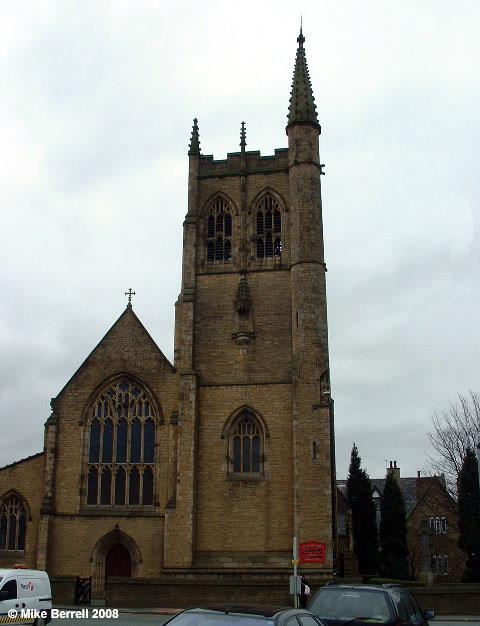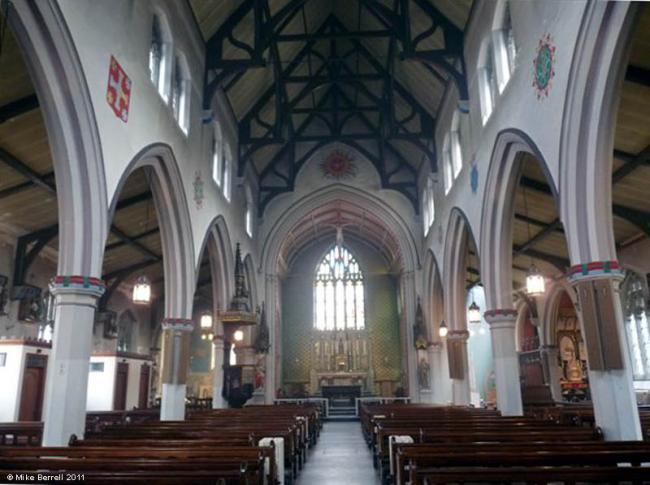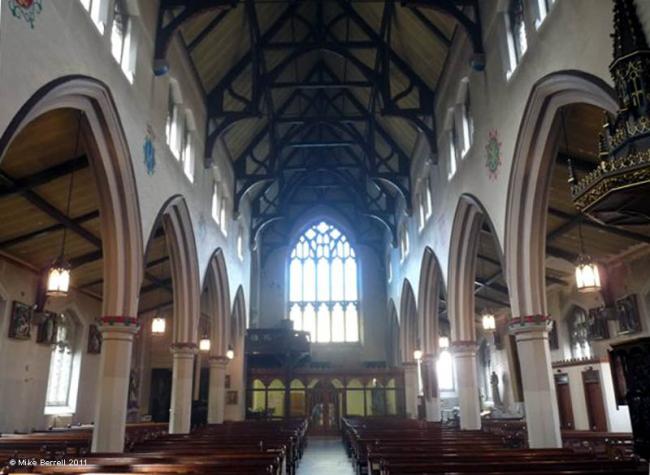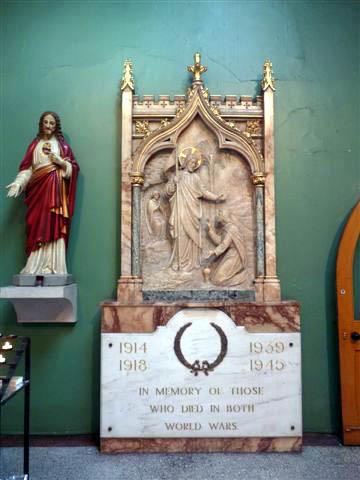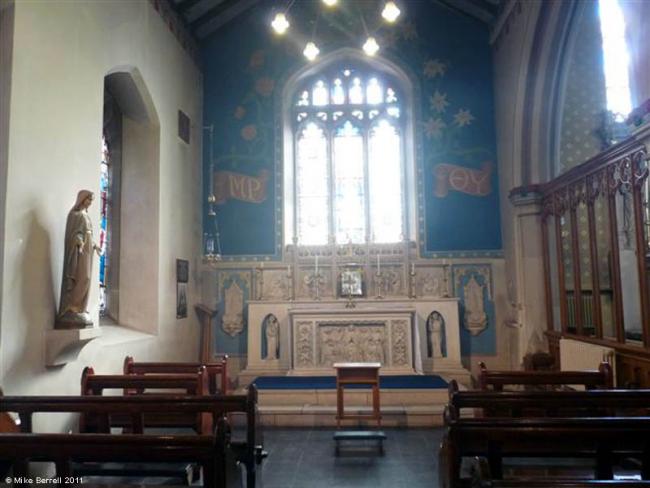Hide
St Chad, Cheetham, Roman Catholic
hide
Hide
Hide
Hide
It was founded in 1847.
Father Edward Helme, who died in 1773, had left £200 for the benefit of the Manchester Catholics for whom he had regularly said Mass in their tiny chapel at Roman Entry in Church Street. He used to travel once a month from Macclesfield to visit the 20 to 30 Catholic families.Father John Orrell and the "Manchester Trustees" of the money built a house and chapel which became known as St. Chad's, Rook Street. Its site was somewhere behind where today are the great stores of Lewis's.
"As to the chapel buildings, they consisted of a number of rooms on the ground floor which formed the residence of the priest, over which extended the chapel. This arrangement secured two objects. It gave a dwelling place for the priest and a chapel on the least extent of ground, and secured a certain degree of privacy by being made to resemble a dwelling house more than a place of worship."
There was no attempt to give it any special beauty on the out side for fear of arousing bigotry. However, on the inside, it had a handsomely decorated altar surmounted by three beautiful paintings - The Nativity, The Trinity, and The Holy Family. What has happened to these paintings since, it would be interesting to discover, especially because nothing seems to be left of the Rook Street chapel, not even a drawing or a picture of it.
There were many rows of pews in the chapel, and on three sides there were galleries to give more accommodation. This style was later copied by other churches, e.g. old St. Augustine's.
"At that time you might see from the upper windows of the building the Cheshire and Derbyshire hills, and it is related that on one occasion the Trafford Hounds chased a hare into the garden attached to the chapel."
The chapel was opened on June 23, 1776. The mission then established comprised a great area: Bolton, Rochdale, Trafford, Stockport, Glossop, and Macclesfield, having a scattered Catholic population of some 600 souls.
The Rook Street site was sold in 1846 and became the premises of Messrs. Sam Ogden and Co. They were destroyed by fire and so no trace is now left.
Old Provost Croskell, whose lifetime spanned most of the nine teenth century, has left it on record that when Father Rowland Broomhead arrived at St. Chad's in 1778 he had a sick-call to Bolton on the very first day of his arrival and was obliged to travel there and back on foot. Truly the founder of Manchester's three famous parishes - St. Chad's, St. Mary's and St. Augustine's was apostolic in more ways than one.
Father Broomhead became the patriarch of Manchester Catholics during the 44 years of his priestly life. He sprang from Stannington about four miles west of Sheffield, and was educated at Sedgeley Park near Wolverhampton and in Rome. He once had the honour of pronouncing an oration in the presence of His Holiness Pope Clement XIV. He was ordained with a dispensation for age, not being as yet 24. He was an assistant priest in Sheffield for two years before settling in Manchester.
Even when he had founded St. Mary's in 1794, his parish still included a wide area, notably Broughton, Cheetham, Ardwick, Stockport, Ashton, Oldham, and Rochdale. Father Broomhead was zealous in attending the sick, even at a great distance, and he was active in the instruction of converts. Some pages from his own pen on his religious work are printed at the end of this section.
On account of his work among the poor he was nominated to several charitable committees. He lived to see the building of the beautiful Gothic church of St. Augustine's, Granby Row, designed by Mr. John Palmer. When Pugin saw the inside of this church he said "This man built a hundred years before his time." Father Broomhead died at Rook Street a month after the opening of St. Augustine's, but he was buried before the high altar at Granby Row, as this church was looked upon as his monument, besides being the finest church that the Catholics had built to date.
The opening of St. Augustine's eclipsed for a time the foundation at St. Chad's, Rook Street. In 1828 Fr. J. Sherwood was appointed. Then in 1842, Fr. Robert Croskell, curate at St. Augustine's was given charge of St, Chad's. He resolved to sell the site at Rook Street for business premises and to build a fine church in the Cheetham area. Rook Street was sold in 1846 and in the same year building was begun at St. Chad's, Cheetham.
Meantime plague victims began to fill the hospitals and the houses of the poor with sick and dying who called for his help. In spite of his constant labours among the sick, Father Croskell managed to supervise the building of the handsome church and rectory at St. Chad's, opened in 1847.
In 1849 Father Croskell was again in the danger zone, tending the victims of the cholera epidemic. He survived the ordeal and in 1852 was sent as Rector to St. Augustine's, but after seven years had a serious breakdown in health. Providence spared him and he lived to be a man of great age, living for 35 years at St. Mary's, Levens-hulme, and becoming Provost of the Chapter until his death in 1902 aged 93.
It was while he was still at St. Chad's that Father Croskell helped Father Gaudentius the Passionist to found the Order of the Cross and Passion nuns, whose mother house is in the Salford Diocese at Deane, Bolton. Father Croskell had the pleasure of seeing the humble foundation in a cottage become a religious order with houses all over the world.
Father William Joseph Sheehan, who had been assistant to Father Croskell, succeeded him as Rector. From 1876 he shared with his former Rector the duties of Vicar-General until his death in 1891. His whole priestly life had been spent at St. Chad's.
For many years St. Chad's was looked upon as the most suitable church for the Vicar-General. Mgr. Canon Gadd resided here from the death of Mgr. Sheehan until 1900.
EXTRACTS FROM LETTERS OF FATHER BROOMHEAD PRESERVED IN THE ARCHIVES OF THE DIOCESE OF HEXHAM AND NEWCASTLE
Rook Street, Manchester,
Sept. 4, 1797
To the Rev. T. Eyre at Crook Hall,The late Bishop had in his possession a Declaration of Trust given by the Trustees of my chapel in Manchester to the Bishop. There is also on the same sheet of stampt paper Rules and Regulations etc. signed by the Bishop, Incumbents, and Trustees. Some little time after the death of the Bishop you proposed sending the above deed to Manchester, but I did not answer your letter, and of course you did not send it; as I find it will be of use to me now, I beg you will send it by the Post as soon as you can.
A copy of these Rules and Regulations has been preserved in the above Archives. It is obvious that Fr. Broomhead had been discussing with the Bishop the problem of how more than one priest should work together in a parish - a new problem in those days. At the end of the "Rules" there is the inscription "Drawn up by Mr. Broomhead, Priest of Manchester, at Stella Hall, May 7, 1790."
Some of these Rules may be quoted for the interest of later generations:
Rule 1.The Senior Priest shall have the whole management of Housekeeping, both with respect to ordering what provisions he may judge necessary, as likewise with respect to hiring, government and discharge of servants.
Rule 2.The necessity of additional assistance to the Maid Servant, of keeping a horse for the mutual service of both priests, and all other necessary and proper expenses belonging to house or Chapel, though not directly to housekeeping shall be determined by the Senior Priest.
Rule 3.This discusses Church property etc.-houses in Church Street being mentioned. This would be the site of; the old chapel at Roman Entry.
Rule 4. The Senior Priest shall not be obliged to serve the Country or outward Congregations without it be his own choice, in which case he shall serve which Congregation he thinks proper.
Rule 5. This is on the house furniture to be provided by the Senior Priest.
Rule 6.This concerns the expense of journeys to the country Congregations.
Rule 7. Whenever company shall be invited to more than a private family dinner or supper, it shall be by mutual consent. But either Senior or Junior Priest may invite Company to a family dinner when no additional dish is prepared than what otherwise would have been provided for themselves . . .
Rule 8.This concerns hospitality. But hospitality shall be shown to all Priests, who call upon them or be otherwise invited, and they shall be treated at the mutual expense of both, the same likewise with respect to the wine used at the altar.
Rule 9.This determines that all mission accounts are to be thoroughly settled every Quarterday.
Rule 10. Respecting Missionary duties. The Senior and Junior Priests shall preach, hear Catechism, say Vespers, and baptise Infants on Sundays alternately and the same shall be observed with respect to preaching etc. on Holydays of Obligation.
Rule 11. Each Priest shall visit his own Penitents, when sick, but when the sick person is not a Penitent of either, the visiting such person shall belong to each in their weekly rotation. The Senior Priest's week for visiting such sick shall commence yearly on the first week in January and shall continue every second week to the end of the year.
Rule 12. Whenever the Senior Priest shall think it necessary to give public instructions in the Chapel upon the Catechism, he shall give one course of Instructions and the Junior the other; but the Senior shall choose whether he gives the first or second course; and Persons applying for instructions at any time, when Public Instructions are not being given, shall receive private instructions from the Priest whose week it is to visit the sick at the time when they first apply for the said instructions.
Rule 13. This makes a similar arrangement for baptising Infants when in danger at private houses or those brought to the Chapel on weekdays.
Rule 14. These Rules and Regulations are not irrevocable, but may be altered when such alterations meet with the mutual consent of both parties concerned . . . The Bishop to give final approval . . .Father Broomhead was a great believer in courses of Public Instructions. He speaks of the work involved in a letter dated November 6, 1806, to the Rev. T. Eyre:
I should have answered your letter sooner, but after Mr. Lupton's Public Instructions which ended a fortnight since, we have not had a moment to spare; one week has been employed in examining converts, first Communicants (many from Ireland of this class from 30 to 40 years old) and long absentees from their duties; another week with the assistance of two other Priests has been employed in hearing their General Confessions; and our sick who have given us some respite for these 2 months past, are now calling on us daily 3 or 4 times.
The following year on February 26, he refers to another course of Public Instructions:
If I cannot find time this week, I shall not be able to do it for a fortnight after, as I shall be totally engaged, along with Rev. Messrs. Lupton, Thompson, Blundell, and Shepherd in taking the Converts, First Communicants (many from Ireland from 20 to 40 years old), and other long absentees (old soldiers, sailors, etc.) into the Church. My Public Instructions will finish on Sunday night next; and we begin to examine those who apply to us to be admitted on Monday morning. The examination will take us four or five days to know if they are sufficiently instructed; and to answer the objections of converts, if they are not sufficiently; convinced of every doctrine of the Catholic Church from what they have heard on Controversy at the Public Instructions.
We have persons of all Religions who attend them, and in general many converts who came at first only out of curiosity. This year I have had an unusual crowd all the time; we have only Mr. Thompson to assist on that week; but the following week we shall all five be employed the whole week from morning till night in the Confessional.
After my last Public Instruction we had 194 General Confessions to hear, of which 34 were converts, besides 7 others of that description who were not sufficiently then instructed. We had also a great many after Mr. Lupton's Public Instructions at the end of the Summer; not less than 20 converts, besides other General Confessions of First Communicants and long absentees. I wish Public Instructions were everywhere adopted; they are of more real service to Religion than all other duties. Mr. Thompson has adopted them at Weldbank, Mr. Shepherd at Bolton, and Mr. Blundell at Stockport with equal great success. A few years since neither Bolton nor Stockport had a Chapel and only a very few straggling Irish Catholics in them; they have each now above 300 in Congregation, besides Children, and you have heard that Mr. Thompson has been obliged to enlarge his Chapel.
An earlier letter (Feb. 27, 1806) gives some interesting details about the state of the Lancashire missions: We are much in want of another Chapel here as the two we have are insufficient for the Congregation. We have in this county 3 pretty large Congregations without priests viz. Blackburn, Wrightington and Croston. At the first lived the late Mr. Dunn, at the second Mons. Delalande, who are both dead and the Congregations large. Mr. Wagstaffe who lived at Croston is removed to Styd Lodge, not far from Blackburn to assist Mr, Fisher, who from a paralytic stroke is incapable of duty ...
Taken from "Salford Diocese and its Catholic past", a survey by Charles A. Bolton, a Priest of the above Diocese. Published 1950 on the First Centenary for the Diocese of Salford.
This site provides historical information about churches, other places of worship and cemeteries. It has no connection with the churches etc. themselves. For current information you should contact them directly.
Original Registers
Baptisms
- 1762 held by Lancashire Record Office RCMC
- 1762 held by Lancashire Record Office RCMC
- 1772-1821 held by Lancashire Record Office RCMC
- 1772-1821 held by Lancashire Record Office RCMC
- 1828-1916 held by Lancashire Record Office RCMC
- 1828-1916 held by Lancashire Record Office RCMC
Marriages
- 1828-1922 held by Lancashire Record Office RCMC
- 1828-1922 held by Lancashire Record Office RCMC
Copies of Original Registers
Baptisms
- 1762 held by Lancashire Record Office MF 9/81-89 - Microfilm
- 1762 held by Lancashire Record Office MF 9/81-89 - Microfilm
- 1772-1821 held by Lancashire Record Office DDX 241/24 - Microfilm
- 1772-1821 held by Lancashire Record Office DDX 241/24 - Microfilm
- 1772-1827 held by Lancashire Record Office MF 9/81-89 - Microfilm
- 1772-1827 held by Lancashire Record Office MF 9/81-89 - Microfilm
- 1828-1916 held by Lancashire Record Office MF 9/81-89 - Microfilm
- 1828-1916 held by Lancashire Record Office MF 9/81-89 - Microfilm
- 1947-1962 held by Lancashire Record Office RCSF 2
- 1947-1962 held by Lancashire Record Office RCSF 2
- 1964 held by Lancashire Record Office RCSF 2
- 1964 held by Lancashire Record Office RCSF 2
Marriages
- 1828-1840 held by Lancashire Record Office DDX 241/24 - Microfilm
- 1828-1840 held by Lancashire Record Office DDX 241/24 - Microfilm
- 1828-1922 held by Lancashire Record Office MF 9/81-89 - Microfilm
- 1828-1922 held by Lancashire Record Office MF 9/81-89 - Microfilm
- 1947-1954 held by Lancashire Record Office RCSF 2
- 1947-1954 held by Lancashire Record Office RCSF 2
- 1961-1964 held by Lancashire Record Office RCSF 2
- 1961-1964 held by Lancashire Record Office RCSF 2
Indexes
Baptisms
- 1847-1856 held by Lancashire Record Office MF 9/83 85 - Microfilm
- 1847-1856 held by Lancashire Record Office MF 9/83 85 - Microfilm
- 1870-1872 held by Lancashire Record Office MF 9/83 85 - Microfilm
- 1870-1872 held by Lancashire Record Office MF 9/83 85 - Microfilm
1762
1772-1821
1772-1821
1772-1827
1828-1916
1828-1916
1847-1856
1870-1872
1947-1962
1964
Marriages
1828-1840
1828-1922
1828-1922
1947-1954
1961-1964
- OpenStreetMap
- Google Maps
- StreetMap (Current Ordnance Survey maps)
- Bing (was Multimap)
- Old Maps Online
- National Library of Scotland (Old Ordnance Survey maps)
- Vision of Britain (Click "Historical units & statistics" for administrative areas.)
- English Jurisdictions in 1851 (Unfortunately the LDS have removed the facility to enable us to specify a starting location, you will need to search yourself on their map.)
- Magic (Geographic information) (Click + on map if it doesn't show)
- GeoHack (Links to on-line maps and location specific services.)

